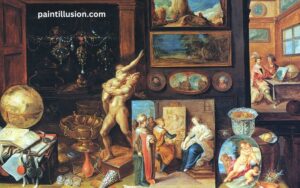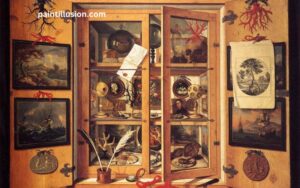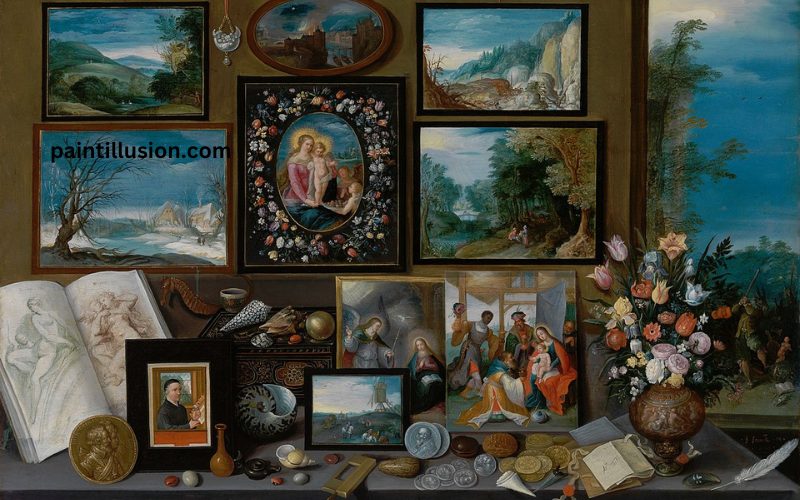Curiosities painting is an extraordinary art form that captures the imagination and invites viewers into a world filled with wonder and intrigue. Through intricate details, mysterious characters, and captivating narratives, curiosities painting transports us to a realm where reality intertwines with the surreal. In this article, we will delve into the history, techniques, and themes of curiosities painting, as well as explore the works of renowned artists in this genre.
The History and Origins of Curiosities Painting
Curiosities painting traces its roots back to the Renaissance period, when artists sought to depict the bizarre and fantastical. During this time, cabinets of curiosities were curated collections of peculiar objects, ranging from peculiar taxidermy specimens to ancient artifacts. These cabinets inspired artists to create paintings that captured the essence of these curious objects.
One of the earliest known curiosities painters is Hieronymus Bosch, whose works such as “The Garden of Earthly Delights” are renowned for their intricate details and fantastical imagery. Bosch’s paintings often depicted scenes that blurred the lines between reality and the supernatural, inviting viewers to contemplate the mysteries of existence.

Exploring the Unique Style and Techniques of Curiosities Painting
Curiosities painting is characterized by its attention to detail and the use of symbolism to convey deeper meanings. Artists in this genre often employ a technique known as trompe-l’oeil, which creates the illusion of three-dimensionality on a two-dimensional surface. This technique adds depth and complexity to the artwork, drawing the viewer into its intricate world.
In addition to trompe-l’oeil, curiosities painters also utilize a wide range of materials and mediums to enhance their artwork. Some artists incorporate found objects, such as antique keys or vintage photographs, into their paintings to imbue them with a sense of history and mystery. Others experiment with unconventional materials, such as feathers or dried flowers, to add texture and visual interest to their compositions.
Famous Curiosities Painters and Their Notable Works
Several artists have made significant contributions to the world of curiosities painting throughout history. Salvador Dali, known for his surrealistic style, created numerous paintings that delve into the realm of curiosities. His iconic work, “The Persistence of Memory,” features melting clocks and distorted figures, evoking a sense of dreamlike wonder.
Another notable artist in this genre is Remedios Varo, whose paintings often depict intricate machines and fantastical landscapes. Her work “The Creation of the Birds” showcases her mastery of detail and her ability to create a sense of otherworldliness.
How Curiosities Painting Has Evolved in Contemporary Art
In contemporary art, curiosities painting has evolved and adapted to reflect the changing times. Artists today continue to explore the themes of mystery and enchantment, but with a modern twist. They incorporate elements of technology, such as digital manipulation and mixed media, to push the boundaries of traditional curiosities painting.
One artist who exemplifies this evolution is Mark Ryden, whose works combine elements of pop culture, mythology, and surrealism. His painting “Incarnation” features a young girl surrounded by peculiar objects, blending elements of innocence and darkness.
The Symbolism and Themes in Curiosities Painting
Curiosities painting often incorporates symbolism and explores various themes. The use of symbols allows artists to convey hidden meanings and invite viewers to contemplate deeper narratives within the artwork.
Common themes in curiosities painting include the exploration of the human psyche, the juxtaposition of life and death, and the interplay between reality and fantasy. Artists use symbolic imagery, such as clocks, mirrors, and masks, to represent the passage of time, the duality of existence, and the masks we wear in our daily lives.

Tips for Creating Your Own Curiosities Painting
If you are inspired to create your own curiosities painting, here are a few tips to get you started:
- Embrace the unconventional: Curiosities painting is all about pushing boundaries and exploring the extraordinary. Don’t be afraid to experiment with different materials, techniques, and subject matter.
- Pay attention to details: The intricate details are what make curiosities painting captivating. Take your time to incorporate small elements that add depth and intrigue to your artwork.
- Tell a story: Curiosities painting often tells a narrative through symbolism and imagery. Consider the story you want to convey and how you can incorporate it into your painting.
Curiosities Painting Exhibitions and Galleries to Visit
If you’re looking to immerse yourself in the world of curiosities painting, there are several exhibitions and galleries around the world that showcase this unique art form. The Museum of Curiosities in London, England, houses a vast collection of curiosities paintings from various artists, both historical and contemporary.
Curiosities Painting as a Form of Storytelling and Expression
Curiosities painting serves as a powerful form of storytelling and expression. Through its intricate details, symbolism, and imaginative narratives, it allows artists to convey their thoughts, emotions, and observations of the world. This art form invites viewers to explore their own curiosities and engage with the artwork on a deeper level.
Conclusion
Curiosities painting is a captivating art form that transports us to a realm filled with wonder and intrigue. By exploring its history, techniques, and themes, we gain a deeper appreciation for the artists who have dedicated themselves to this genre. Whether you are an artist or an art enthusiast, curiosities painting invites you to embrace the extraordinary and explore the mysteries of our world. So go forth, unleash your curiosity, and create your own masterpiece in the world of curiosities painting.


great post, very informative. I ponder why the other specialists of this sector don’t understand this. You must proceed your writing. I’m confident, you have a great readers’ base already!